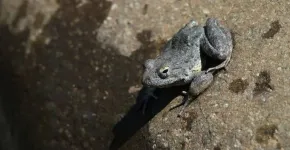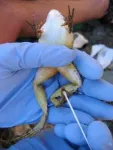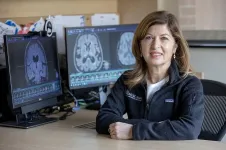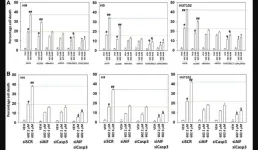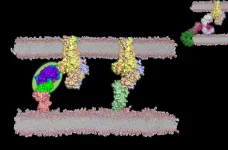(Press-News.org) (Santa Barbara, Calif.) — Up to only a few inches in length, with a lemon-hued belly, the foothill yellow-legged frog may seem unassuming. But its range once stretched from central Oregon to Baja California. In 2023, it was listed under the federal Endangered Species Act. Its rapidly decreasing range is due in part to a fungal pathogen called Batrachochytrium dendrobatidis, or Bd, that has devastated amphibians around the world.
A team of researchers, including UC Santa Barbara’s Andrea Adams, has conducted the most comprehensive study to date of disease dynamics in foothill yellow-legged frogs. The team’s data — sourced from both wild frogs and specimens in museum collections — enabled them to track patterns of infection across a large geographic range. In a study published in Royal Society Open Science, the researchers reveal that drought, rising temperatures and the increasing conversion of land for agriculture appear to be the largest factors driving Bd infection in this species.
The researchers aimed to assemble as much data as they could, both in space and time. They surveyed in the creeks and rivers of California and Oregon, where they swabbed wild yellow-legged frogs for the presence of Bd. It also led them into fluorescent-lit museum collections to sample specimens from as far back as the 1890s.
The team leveraged a large network of people and institutions to amass this wealth of samples. “Many foothill yellow-legged frog field researchers had data that they weren’t actively analyzing,” said co-author Adams, of UCSB’s Earth Research Institute. “And so we were able to bring all of this data together and get it into a usable format that we could use to paint a much bigger picture of what is, and was, going on with Bd in this species.”
The researchers swabbed each frog’s skin to determine if the animal was infected. To test for Bd, they used a PCR test, similar to some tests for COVID. By searching for Bd DNA from thousands of samples, the researchers were able to identify infection rates and severity. Co-lead author Ryan Peek ran this information through statistical models, which accounted for climatic, geographic, biologic and land use variables. This enabled the team to track disease patterns across a large geographic range over roughly 120 years.
The team discovered that disease patterns of Bd aligned with historical frog declines. The pathogen began to spread in the 1940s from the southern coast of California, moving northward and eventually affecting nearly the entire region. The biggest factors driving infection seem to be drought, increasing temperatures and the use of ever more land for agriculture.
Bd is a fungus that is spread through spores in the water, but that spread may occur differently in foothill yellow-legged frogs in different regions and climates, the researchers found. In some places, drought increased infection, while in others, it did not, possibly because of the presence or absence of other species that can carry Bd and share the same water, such as American bullfrogs, a species introduced from eastern North America.
“If you combine the fact that there are bullfrogs building up the number of spores that these frogs are exposed to, and then they’re all kind of stuck in these small pools together, that explains why drought matters. They are suddenly getting hit with a really large number of spores and getting sick and dying,” said lead author Anat Belasen, a postdoctoral fellow at UT Austin and research affiliate with the Smithsonian Conservation Biology Institute. What’s more, foothill yellow-legged frogs live exclusively in streams and rivers, not ponds and lakes. So the species is already stressed when these waterways shrink into isolated pools.
The progression of Bd in the foothill yellow-legged frog also differed from its course in other western amphibians. In many other species, the disease radiated from urban centers, rather than this clear south-to-north trend. What’s more, the disease showed up later in the foothill yellow-legged frog than in other species in its range. “These findings open more questions about what was stopping transmission and what allowed it to happen later,” Belasen said.
Frogs switch from herbivores as tadpoles to carnivores as adults, which means they connect different nutrient cycles together in the food web. Their position at the center of the food chain also influences the ecosystem.
“When you remove frogs from an ecosystem, what you get is less control of insects, things that the frogs would eat,” Belasen said. “There is also less food for things that eat the frogs, like snakes, birds and small mammals. It really throws things off and makes the ecosystem less stable and less functional.”
The conversion of land for agriculture was another major factor influencing the spread of Bd. “There are areas that have wet soils that would be alongside suitable habitat for these frogs,” Belasen said. “In areas where more of those lands have been converted to agriculture, we see a higher risk of frogs being infected with the fungus.”
In addition to disease hotspots, the team also identified a number of cold spots — areas where the pathogen is present but less influential. The existence of so many cold spots in different areas is a good sign, as it may mean that many areas have conditions suitable for keeping disease rates low, even as climate change increases temperatures and patterns of drought.
The authors are curious what might explain this clustering, especially when cold spots appear in unexpected locations: for example, places with similar habitat, land-use and climatic impacts as hotspots. It suggests there may be some genetic basis for the differences, whether on the pathogen side or the host side. Adams is currently researching the feasibility of reintroducing foothill yellow-legged frogs to Southern California.
The results of this paper shed a lot of light on the dynamics of where Bd occurs, what drives its spread and how the pathogen and frog may interact in the future. “We took a big snapshot of this species’ disease relationship through time,” Adams said. Earlier studies provided the researchers with glimpses into disease patterns in smaller geographic regions, “but now we have a much larger dataset that further confirms many of these patterns, and expands on them.”
Support for this research was provided in part by the Cedar Tree Foundation, National Science Foundation, Schmidt Family Foundation and the U.S. Geological Survey.
END
Scientists assemble a richer picture of the plight and resilience of the foothill yellow-legged frog
Researchers have mapped the spread of a fungal infection ravaging an endangered frog, revealing some of the factors driving the epizootic
2024-02-26
ELSE PRESS RELEASES FROM THIS DATE:
Neuropsychiatric symptoms predict which patients with mild cognitive impairment develop Alzheimer’s disease.
2024-02-26
As the years add up, it's common to notice slight changes in our ability to remember and think. Older people who have more marked changes than their peers can be diagnosed with mild cognitive impairment (MCI). Currently, we can’t easily predict which of these patients will develop Alzheimer’s disease and which will not.
“It's hard to predict which patients will have a more rapid progression and receive a diagnosis of dementia,” said Maria Vittoria Spampinato, M.D., division director of Neuroradiology at the Medical University of South Carolina.
“It’s important ...
Resurrecting niobium for quantum science
2024-02-26
For years, niobium was considered an underperformer when it came to superconducting qubits. Now scientists supported by Q-NEXT have found a way to engineer a high-performing niobium-based qubit and so take advantage of niobium’s superior qualities.
When it comes to quantum technology, niobium is making a comeback.
For the past 15 years, niobium has been sitting on the bench after experiencing a few mediocre at-bats as a core qubit material.
Qubits are the fundamental components of quantum devices. One qubit type relies on superconductivity to process information.
Touted for its superior qualities as a superconductor, niobium was always a promising ...
Long-term data reveals SARS-CoV-2 infection and vaccine-induced antibody responses are long-lasting
2024-02-26
A long-term analysis conducted by leading microbiologists at the Icahn School of Medicine at Mount Sinai reveals that antibody responses induced by COVID-19 vaccines are long-lasting. The study results, published online in the journal Immunity on February 22, challenge the idea that mRNA-based vaccine immunity wanes quickly.
The emergence of SARS-CoV-2, the virus that causes COVID-19, in late 2019 sparked the global pandemic that is now in its fifth year. Vaccines that were developed at record speed have saved millions of lives. However, the emergence of SARS-CoV-2 variants and waning immunity have decreased ...
Shaping the future of phage therapy: The 7th World Conference on Targeting Phage Therapy in Malta aims to transform clinical trials through translational research
2024-02-26
The 7th World Conference on Targeting Phage Therapy 2024, two-day event dedicated to advancing the field of phage research and therapy will be hosted at Corinthia Palace Malta on June 20-21.
Robert T. Schooley, M.D., Professor of Medicine at the University of California, San Diego, Co-Director of the Center for Innovative Phage Applications and Therapeutics, and member of the Executive Committee for the University of California Disaster Resilience Network, will introduce the messages and strategies behind phages therapy 2024.
His talk titled “Phage Therapeutics 2024: Essential Translational Research Components for ...
GZ17-6.02 with bexarotene kills mycosis fungoides cells
2024-02-26
“The present studies were performed to extend our knowledge of GZ17-6.02 biology from that known in solid tumor cell types such as prostate cancer cells to liquid tumor cell types, for example, mycosis fungoides.”
BUFFALO, NY- February 26, 2024 – A new research paper was published in Oncotarget's Volume 15 on February 8, 2024, entitled, “GZ17-6.02 interacts with bexarotene to kill mycosis fungoides cells.”
In this new study, researchers Michael R. Booth, Laurence Booth, Jane L. Roberts, Cameron West, and Paul Dent from Virginia Commonwealth University and Genzada Pharmaceuticals investigated the therapeutic agent GZ17-6.02, composed of curcumin, ...
University of Tennessee Health Science Center professor awarded $1.5m to study 'root causes' of disparity in breast cancer survival of Black women and white women
2024-02-26
Memphis, Tenn. (February 26, 2024) – Shelley White-Means, PhD, a professor of Health Economics in the Department of Interprofessional Education and the director of the Consortium for Health Education, Economic Empowerment and Research (CHEER) at UT Health Science Center, recently received a $1.5 million, four-year grant from the National Institute on Minority Health and Health Disparities to explore the root causes of the disparity in breast cancer survival of Black women compared to white women.
Dr. White-Means and a team will look beyond the social determinants of health to explore what she terms “the intersectionality of race, ...
Steering and accelerating electrons at the microchip scale
2024-02-26
Stanford researchers are getting closer to building a tiny electron accelerator based on “accelerator-on-a-chip” technology with broad potential applications in studying physics as well as medical and industrial uses.
The researchers have demonstrated that a silicon dielectric laser accelerator, or DLA, can now both speed up and confine electrons, creating a focused beam of high-energy electrons. “If the electrons were microscopic cars, it’s as if, for the first time, we’re steering and we have our foot on the gas,” said Payton Broaddus, PhD ’23 in electrical engineering and the lead author on a paper published on ...
City of Hope scientists devise novel strategy to seek and destroy leukemia stem cells
2024-02-26
FINDINGS
Scientists at City of Hope, one of the largest cancer research and treatment organizations in the United States, have devised an innovative approach to target and destroy hard-to-kill leukemia stem cells. The journal Blood published the preclinical findings today.
By overcoming challenges, such as drug resistance and treatment relapse common to patients with acute myeloid leukemia (AML), the therapy method could provide a less toxic and more effective approach for older and sicker patients who don’t quality for stem cell transplants — currently the only cure for AML available.
Type II interferon (IFNy), a substance produced by immune cells, disrupts ...
Laser-focused look at spinning electrons shatters world record for precision
2024-02-26
NEWPORT NEWS, VA – Scientists are getting a more detailed look than ever before at the electrons they use in precision experiments.
Nuclear physicists with the U.S. Department of Energy’s Thomas Jefferson National Accelerator Facility have shattered a nearly 30-year-old record for the measurement of parallel spin within an electron beam – or electron beam polarimetry, for short. The achievement sets the stage for high-profile experiments at Jefferson Lab that could open the door to new physics discoveries.
In a peer-reviewed ...
BU researchers identify potential new subtype of chronic traumatic encephalopathy
2024-02-26
FOR IMMEDIATE RELEASE, February 26, 2024
Contact: Gina DiGravio, 617-358-7838, ginad@bu.edu
BU Researchers Identify Potential New Subtype of Chronic Traumatic Encephalopathy
One in six cases have a distinct distribution of disease, clinical profile
(Boston)—Chronic traumatic encephalopathy (CTE) is a neurodegenerative disease defined by abnormal tau protein accumulating in a particular pattern in specific regions of the brain.
Studies to-date suggest CTE begins in the outermost layer of the frontal lobe, the neocortex, where it then spreads to connected brain regions. Later, in high-stage disease, ...
LAST 30 PRESS RELEASES:
Interaction of climate change and human activity and its impact on plant diversity in Qinghai-Tibet plateau
From addressing uncertainty to national strategy: an interpretation of Professor Lim Siong Guan’s views
Clinical trials on AI language model use in digestive healthcare
Scientists improve robotic visual–inertial trajectory localization accuracy using cross-modal interaction and selection techniques
Correlation between cancer cachexia and immune-related adverse events in HCC
Human adipose tissue: a new source for functional organoids
Metro lines double as freight highways during off-peak hours, Beijing study shows
Biomedical functions and applications of nanomaterials in tumor diagnosis and treatment: perspectives from ophthalmic oncology
3D imaging unveils how passivation improves perovskite solar cell performance
Enriching framework Al sites in 8-membered rings of Cu-SSZ-39 zeolite to enhance low-temperature ammonia selective catalytic reduction performance
AI-powered RNA drug development: a new frontier in therapeutics
Decoupling the HOR enhancement on PtRu: Dynamically matching interfacial water to reaction coordinates
Sulfur isn’t poisonous when it synergistically acts with phosphine in olefins hydroformylation
URI researchers uncover molecular mechanisms behind speciation in corals
Chitin based carbon aerogel offers a cleaner way to store thermal energy
Tracing hidden sources of nitrate pollution in rapidly changing rural urban landscapes
Viruses on plastic pollution may quietly accelerate the spread of antibiotic resistance
Three UH Rainbow Babies & Children’s faculty elected to prestigious American Pediatric Society
Tunnel resilience models unveiled to aid post-earthquake recovery
Satellite communication systems: the future of 5G/6G connectivity
Space computing power networks: a new frontier for satellite technologies
Experiments advance potential of protein that makes hydrogen sulfide as a therapeutic target for Alzheimer’s disease
Examining private equity’s role in fertility care
Current Molecular Pharmacology achieves a landmark: real-time CiteScore advances to 7.2
Skeletal muscle epigenetic clocks developed using postmortem tissue from an Asian population
Estimating unemployment rates with social media data
Climate policies can backfire by eroding “green” values, study finds
Too much screen time too soon? A*STAR study links infant screen exposure to brain changes and teen anxiety
Global psychiatry mourns Professor Dan Stein, visionary who transformed mental health science across Africa and beyond
KIST develops eco-friendly palladium recovery technology to safeguard resource security
[Press-News.org] Scientists assemble a richer picture of the plight and resilience of the foothill yellow-legged frogResearchers have mapped the spread of a fungal infection ravaging an endangered frog, revealing some of the factors driving the epizootic
